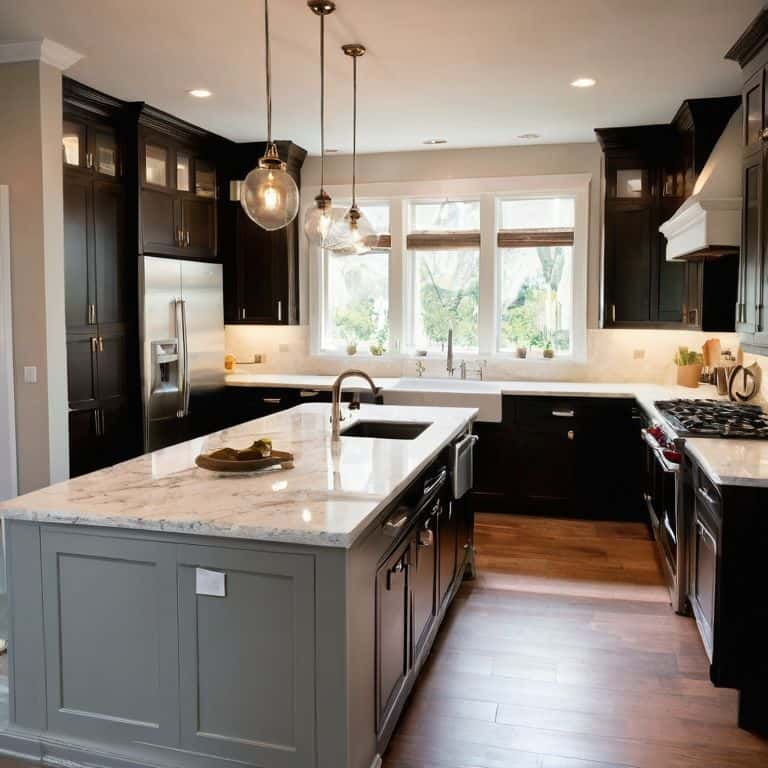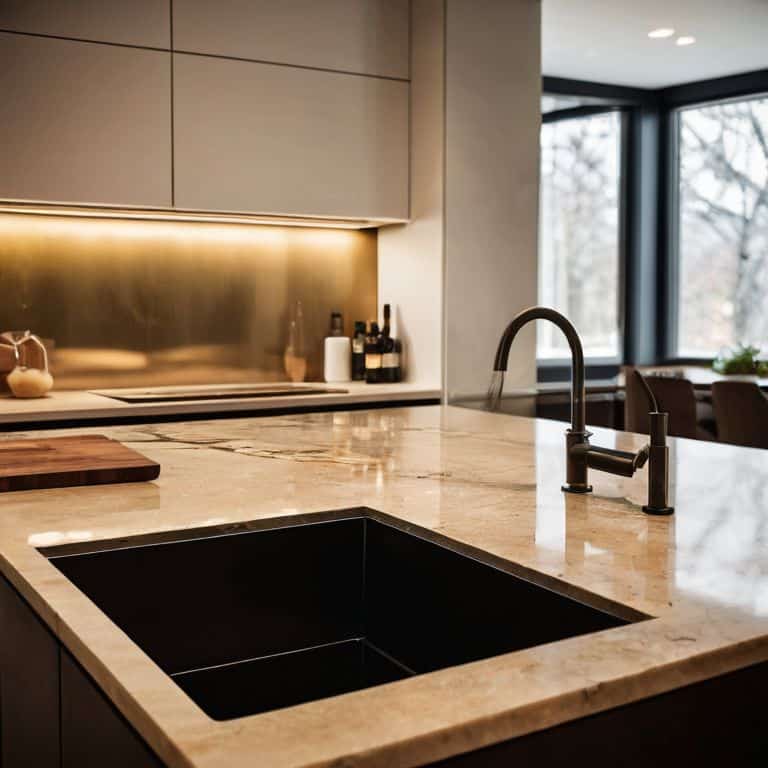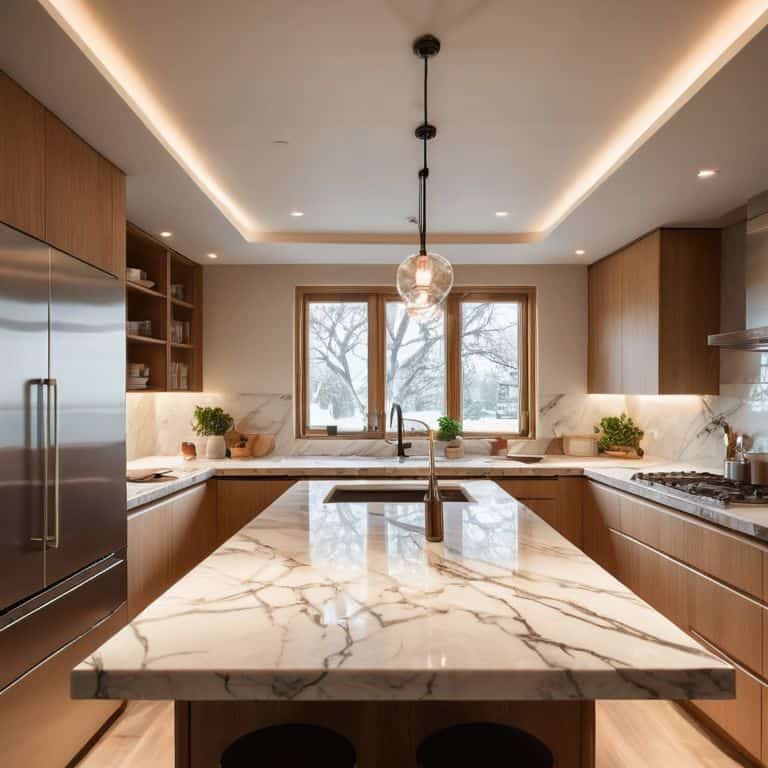I still remember the first time I walked into a kitchen with perfectly layered lighting – it was like a warm hug for my senses. I was visiting a friend’s new home, and as we cooked dinner together, I noticed how the different light sources worked in harmony to create a space that was both functional and beautiful. This experience sparked my passion for helping others learn how to layer lighting in a kitchen, and I’ve since made it my mission to share practical tips and tricks for achieving this ambiance. Whether you’re a seasoned chef or a culinary newbie, the right lighting can make all the difference in your cooking experience.
As someone who’s worked with numerous clients to design their dream kitchens, I’ve seen firsthand how a well-lit space can transform the cooking process. In this article, I’ll share my expertise on how to layer lighting in a kitchen, from the basics of ambient, task, and accent lighting to more advanced techniques for creating a unique atmosphere. You’ll learn how to assess your kitchen’s specific needs, choose the right light fixtures, and create a layered lighting plan that works for you. My goal is to empower you with the knowledge and inspiration to create a kitchen that’s not only functional but also a joy to spend time in.
Table of Contents
Guide Overview: What You'll Need

Total Time: 2 hours 30 minutes
Estimated Cost: $100 – $300
Difficulty Level: Intermediate
Tools Required
- Drill (with screwdriver and drill bits)
- Level (to ensure proper installation)
- Tape measure (for measuring spaces)
- Pliers (for gripping small objects)
- Screwdriver (flathead and Phillips)
Supplies & Materials
- LED light strips (for under-cabinet lighting)
- Recessed light fixtures (for general lighting)
- Pendant lights (for task lighting over islands or sinks)
- Dimmer switches (for controlling light levels)
- Wire connectors (for connecting light fixtures)
- Electrical wire (14-gauge or 12-gauge, depending on the setup)
Step-by-Step Instructions
- 1. First, let’s start by understanding the basics of layering lighting in a kitchen. This means we’ll be working with three main types of lighting: ambient, task, and accent lighting. To begin, take stock of your kitchen’s existing lighting and identify areas where you might need more illumination. I like to use a lighting audit checklist to help me stay organized and focused on the task at hand.
- 2. Next, think about the ambient lighting in your kitchen. This type of lighting provides overall illumination and sets the tone for the space. Consider installing recessed lighting or pendant lights to create a warm and inviting atmosphere. When choosing ambient lighting fixtures, remember to select options that are energy-efficient and easy to maintain.
- 3. Now, let’s move on to task lighting, which is designed to help you perform specific tasks, such as cooking or food preparation. Under-cabinet lighting is a great example of task lighting, as it provides focused illumination on countertops and workspaces. Look for LED light strips or small pendant lights that can be installed under your cabinets to create a functional and well-lit workspace.
- 4. Once you have your ambient and task lighting in place, it’s time to think about accent lighting. This type of lighting is used to draw attention to specific design elements or features in your kitchen, such as a beautiful backsplash or a statement piece of artwork. Consider using track lighting or spotlights to create a dramatic and visually appealing effect.
- 5. To create a truly layered lighting effect, you’ll want to mix and match different light sources. Combine overhead lighting with under-cabinet lighting and table lamps to create a warm and inviting atmosphere. Don’t be afraid to experiment with different lighting temperatures and intensities to find the perfect balance for your kitchen.
- 6. As you’re planning your lighting design, remember to consider the kitchen work triangle. This refers to the path between your sink, stove, and refrigerator, and it’s an important area to focus on when it comes to lighting. Make sure to provide adequate task lighting in this area to create a functional and efficient workspace. I like to use a zoning approach to lighting, where I divide the kitchen into different zones and prioritize lighting for each area.
- 7. Finally, don’t forget to add some decorative lighting to your kitchen to create a warm and welcoming ambiance. This could be as simple as adding some candles or string lights to your kitchen island or dining table. You could also consider installing LED light panels or glow-in-the-dark accents to create a unique and eye-catching effect. Whatever you choose, make sure it reflects your personal style and adds to the overall cozy atmosphere of your kitchen.
Layering Kitchen Lights

When it comes to layered lighting design principles, I always say that it’s all about creating a harmonious balance between different light sources. In my own kitchen, I’ve installed under cabinet lighting options that provide a warm glow, perfect for cooking and food preparation. This type of lighting is not only functional, but it also adds a touch of elegance to the space.
To take your kitchen lighting to the next level, consider incorporating recessed lighting in kitchen ceilings. This type of lighting provides overall illumination and can help to create a sense of openness in the room. Additionally, dimming options for kitchen lights can be a game-changer, allowing you to adjust the lighting to suit your needs. Whether you’re cooking a meal or hosting a dinner party, being able to control the lighting can make all the difference.
In terms of energy efficient kitchen lighting solutions, there are many options available that can help to reduce your energy consumption while still providing ample lighting. From LED light bulbs to smart lighting systems, the choices can be overwhelming. However, by doing some research and considering your specific needs, you can find a solution that works for you and helps to create a beautiful and functional kitchen space.
Recessed Ceiling Lighting
When it comes to recessed ceiling lighting, I like to think of it as the foundation of my kitchen’s lighting ecosystem. It provides overall illumination, making it easier to navigate the space. To get it just right, consider the size and spacing of your recessed lights – you want to avoid harsh shadows or overly bright spots. I recommend using a combination of 4-6 inch recessed lights, spaced about 3-4 feet apart, to create a warm and inviting glow.
For a more polished look, try using recessed lights with a baffle trim to reduce glare and minimize harsh light spill. This will help create a soft, ambient light that’s perfect for everyday cooking and entertaining. Plus, it’s a great way to make your kitchen feel more spacious and open.
Under Cabinet Glow Options
When it comes to layering kitchen lights, one of my favorite techniques is adding an under cabinet glow. Not only does it provide extra illumination for food prep, but it also creates a warm ambiance that makes cooking feel more enjoyable. I love using LED light strips or small puck lights under my cabinets to create a soft, warm glow.
For a more budget-friendly option, consider using plug-in under cabinet lights. They’re easy to install and can be just as effective as hardwired options. Plus, they come in a variety of styles and finishes to fit your kitchen’s aesthetic. Whether you’re chopping veggies or mixing cocktails, under cabinet lighting can add a touch of sophistication to your kitchen workflow.
Shine On: 5 Essential Tips for Layering Lighting in Your Kitchen
- Illuminating the Task at Hand: Use focused lighting, like under-cabinet LEDs, to brighten countertops and reduce shadows where you’ll be chopping, slicing, and mixing
- Create Ambient Warmth: Recessed lighting can provide overall illumination, but consider adding table or floor lamps to introduce a cozier glow, perfect for dinner parties or family gatherings
- Don’t Forget the Power of Natural Light: If possible, position your kitchen to maximize natural light, and use sheer curtains or blinds to filter and soften the sun’s rays, reducing glare on countertops
- Add a Touch of Drama with Accent Lighting: Highlight your favorite kitchen features, like a stunning backsplash or a beautiful kitchen island, with strategically placed spotlights or LED tape lights
- Experiment with Layering Light Temperatures: Mixing warm and cool light sources, such as incandescent bulbs and LED strips, can add depth and visual interest to your kitchen, making it feel more inviting and layered
Key Takeaways for a Harmonious Kitchen
I’ve learned that layering lighting in the kitchen is all about striking a balance between form and function – it’s not just about throwing some lights in, but creating a thoughtful, intentional space that inspires you to cook and connect with loved ones
From under cabinet glow options to recessed ceiling lighting, the right mix of task, ambient, and accent lighting can completely transform your kitchen’s ambiance and workflow, making it easier to chop, dice, and savor every moment
Whether you’re a busy home cook or an entertaining enthusiast, investing time in getting your kitchen lighting just right will pay dividends in the long run – trust me, it’s worth experimenting with different layering approaches to find the perfect blend that reflects your unique style and cooking personality
Illuminating Insights
Layering lighting in your kitchen is not just about brightness, it’s about crafting an ambiance that nurtures both the cook and the conversation – it’s where function meets feeling, and every layer tells a story of warmth and welcome.
Clara Wu
Bringing it all Together: A Brighter Kitchen

As we’ve explored the world of layered lighting in kitchens, it’s clear that creating a harmonious balance between different light sources is key. From under cabinet glow options to recessed ceiling lighting, each element plays a crucial role in crafting a space that’s both functional and inviting. By considering the unique needs of your kitchen and applying the principles outlined in this guide, you’ll be well on your way to designing a lighting scheme that enhances your cooking experience and makes your kitchen a joy to spend time in.
So, as you embark on your own kitchen lighting journey, remember that it’s all about striking a balance between form and function. Don’t be afraid to experiment and try out new ideas – and most importantly, have fun with the process! With a little creativity and attention to detail, you can create a kitchen that’s not only a beautiful space, but also a hub of warmth and connection where memories are made and delicious meals are shared.
Frequently Asked Questions
What are the best types of light bulbs to use for under cabinet lighting to get a warm and inviting glow?
For a warm and inviting glow under your cabinets, I swear by warm white LED bulbs with a color temperature around 2700K-3000K. They provide a soft, gentle light that’s perfect for ambiance and task lighting. Look for bulbs with a high CRI (color rendering index) for the most flattering glow.
How do I determine the optimal placement of recessed ceiling lights in my kitchen to avoid harsh shadows?
To avoid harsh shadows, I recommend placing recessed ceiling lights at least 24-36 inches apart, and about 12-18 inches away from any cabinets or walls. This will help create a soft, even glow. Also, consider the ‘work triangle’ – place lights to illuminate the spaces between your sink, stove, and fridge for optimal workflow.
Can I effectively layer lighting in a small kitchen with limited natural light, and what are some tips for making the space feel brighter and more welcoming?
In small kitchens with limited natural light, layering lighting is crucial. I recommend starting with warm overhead lighting, then adding under-cabinet LED strips to create a cozy glow. Consider installing a skylight or solar tube if possible, and don’t forget to use light-colored finishes and reflective surfaces to bounce light around the space.
